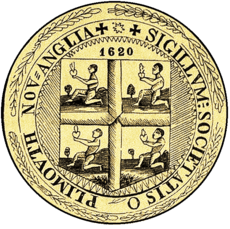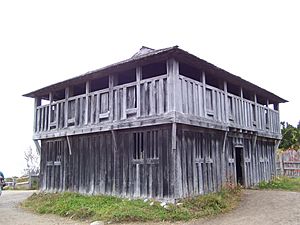Plymouth General Court facts for kids
Quick facts for kids The General Court of the Plymouth Colony |
|
|---|---|

Seal of the Plymouth Colony
|
|
| Type | |
| Houses | Upper House (de facto): Council of Assistants Lower House (de facto): Assembly (1620-1639) Assembly of Freemen (1639-1691) |
| History | |
| Founded | 1620 |
| Disbanded | 1691 |
| Succeeded by | (1686-1689) Council of New England (After 1691) Great and General Court of Massachusetts Bay |
| Leadership | |
| Meeting place | |
 |
|
| Burial Hill | |
| Constitution | |
| Agreement Between the Settlers of New Plymouth | |
The Plymouth General Court was the main governing body of the Plymouth Colony from 1620 to 1692. It acted like a modern-day state legislature, making laws for the colony. It also served as a high court, handling important legal cases and appeals.
Contents
The Court's Beginning
The Plymouth General Court was started in 1620. This was when the Pilgrims first arrived in New England. It was both the law-making group and the main court for the colony.
In 1636, the Court created North America's first written set of laws. These laws included basic rights for people. For example, they protected the right to a jury trial. This meant people accused of a crime could have a group of citizens decide their case.
The early laws were based on English common law. They also used some ideas from Mosaic law (laws from the Bible). The court system was similar to local courts in England. The General Court met inside the fort on Burial Hill in Plymouth.
How the Court Worked
At first, the General Court included the colony's Governor. It also had the Council of Assistants, who helped the Governor. All the colony's "Freemen" were also part of it. Freemen were adult men who had certain rights.
Unlike other colonies, all leaders of the General Court were chosen directly by the Freemen. In the beginning, only the men who signed the Mayflower Compact were considered Freemen. The Governor and Assistants acted as judges. The Freemen met in an open assembly to make laws.
This direct way of governing was like a town meeting. Many New England towns still use this system today. However, it became hard for colonists to travel to the General Court. So, changes were made in 1639.
After 1639, Freemen from each town could elect delegates. Most towns chose two delegates. The town of Plymouth was allowed to choose four. These delegates acted as local judges. They also served as representatives in the General Court. People could remove delegates if they caused problems. Even with these changes, the main leaders were still elected by all Freemen.
Who Could Be a Freeman?
The rules for who counted as a "Freeman" changed over time. Initially, only those who signed the Mayflower Compact were Freemen. Later, more people could sign up.
However, some groups were not allowed to be Freemen. This included Quakers and Ranters. They were excluded because they would not take an oath of loyalty. Taking an oath was required to sign the Compact.
In 1671, the rules became more open. Any Puritan man over 21 years old could be a Freeman. They also needed to own property worth more than £20.
The End of the Court
The Plymouth Colony officially became part of the Province of Massachusetts Bay on October 7, 1691. However, the Plymouth General Court kept governing until May 14, 1692. That's when the new leader, William Phips, arrived with the new charter.
The last official meeting of the Plymouth General Court was on June 8, 1692. It was officially closed down that year. The Massachusetts General Court and the Massachusetts Supreme Judicial Court then took over its duties.
See also
 In Spanish: Tribunal General de Plymouth para niños
In Spanish: Tribunal General de Plymouth para niños

